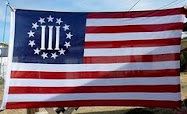 Freedom Shenanigan #49
Freedom Shenanigan #49From http://social.venturebeat.com/2010/07/02/facial-recognition-camouflage/
The day when you’ll be able to hold up your phone and identify a stranger through a viewfinder is getting closer.
Google’s Goggles, a mobile app for visual search, has a facial recognition version unreleased to the public, while Israeli startup Face.com’s technology can tag people’s faces in Facebook photos. Facebook even released a basic version of face detection last night, although it doesn’t have recognition.
So in a world where technology chips away at our ability to remain anonymous, how does one reclaim some semblance of control?
It turns out there’s actually a pretty simple way around the facial recognition technology available in the market today, according to Adam Harvey, a graduate student at NYU’s ITP (the same program that produced Foursquare chief executive Dennis Crowley and that Twitter’s location guru Raffi Krikorian taught at).
If you change the contrast in certain parts of your face — either through a watermark or by wearing a strategically-placed sticker or facepaint, recognition technology can’t identify that your face is a human face.
“It breaks apart the gestalt of the face,” he said. “That’s what original camouflage was supposed to do.”
Harvey sa id he got his idea from studying camouflage methods use during World War I and World War II. His project, CV Dazzle, is based on the original dazzle camouflage used by the military to hide ships in the 1940s.
id he got his idea from studying camouflage methods use during World War I and World War II. His project, CV Dazzle, is based on the original dazzle camouflage used by the military to hide ships in the 1940s.
While the flashy geometric patterns don’t seem like they would be able obscure a thing, they thwarted the enemy’s ability to tell the make or size of the ship. Similarly, zebra camouflage does little to blend the animal into the background of the savannah. But when zebras are in herds, predators like lions have difficulty picking out animals from the herd. (Dazzle camouflage was eventually phased out by the military as aviation technology and rangefinders improved.)
Harvey says there a couple of projects that could stem from idea. He could either build a basic watermarking technology that could render faces unidentifiable to these programs while still being recognizable to humans. Or he could work with make-up artists and designers to create interesting real-world looks that prevent facial recognition.
“Putting paint on your face isn’t always practical,” he said. “This is just the way that I wanted to test this. But if you wanted to be covert, you could try wearing different styles of make-up or accessories. You could position a Band-aid on the right spot on your face. The power of this idea is that people can interpret it in their own way.”
You can see face-detection evading makeup below. The examples that have red squares around them were identified. But the ones that don’t have squares passed facial recognition software undetected.

It seems like a pretty far-off idea given that if Facebook ever did release full-fledged facial recognition, it would never be completely automated. Humans would most likely have final say to tag or untag themselves. It’s also unclear how Google could ever release a facial recognition Google Goggles, given the privacy concerns it is already facing from European governments and consumers alike.
But if an augmented reality app that automatically identified people from your phone ever emerged, perhaps we could see a fad of facial camouflage.
CV Dazzle vs PhotoTagger from Adam Harv on Vimeo.
























